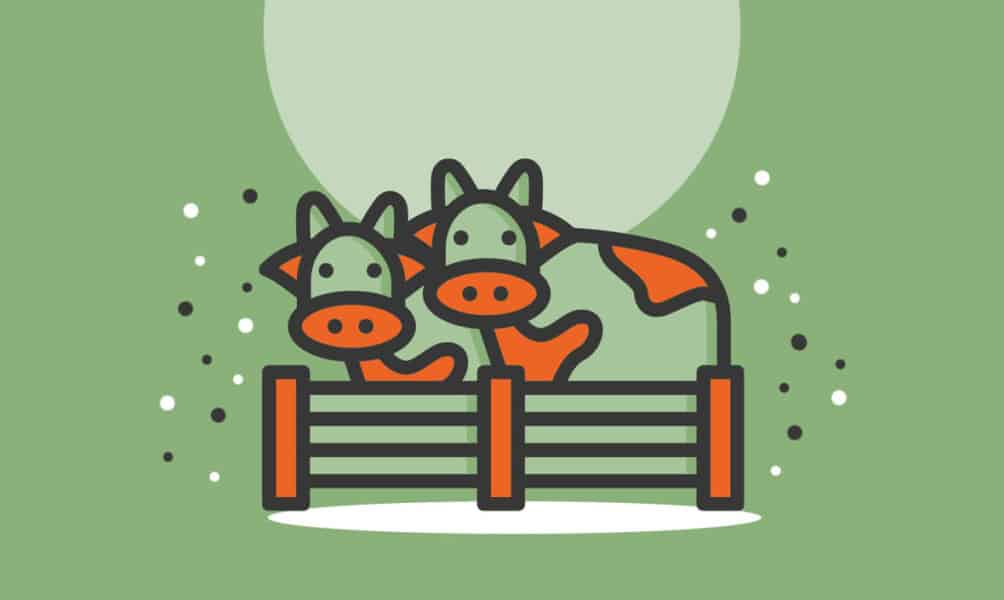
Carolyn Young is a business writer who focuses on entrepreneurial concepts and the business formation. She has over 25 years of experience in business roles, and has authored several entrepreneurship textbooks.
David has been writing and learning about business, finance and globalization for a quarter-century, starting with a small New York consulting firm in the 1990s.
Published on May 18, 2022

$208,000 - $520,000 p.a.
$62,000 - $156,000 p.a.
Here are the most important factors to consider when starting a cattle farm:
![]()
Interactive Checklist at your fingertips—begin your cattle farm today!
You May Also Wonder:
Is a cattle farm profitable?
Yes, a cattle farm can be profitable. It will take time to start making money since you have to wait until the cattle get to their ideal weight to sell them, but after a few years, you should be turning a nice profit.
How should I price my beef products?
Prices for cows are very volatile, so it will depend on the market at any given time. Cows are sold by their total weight, with the price set per 100 pounds.
Which state is best for cattle farming?
Kansas, Oklahoma, and Texas are good states for cattle farming because they have a solid infrastructure to support farmers. Land in those states is also inexpensive.
Where is the cheapest place to start a farm?
Montana, Oklahoma, and Wyoming have the cheapest farmland prices. South Dakota and North Dakota are also affordable.
How do I start a cattle farm with no money?
You can’t start a cattle farm with no money. Costs are at least $300,000. However, the USDA can help you access financial resources, and they offer other support services to help beginning farmers.
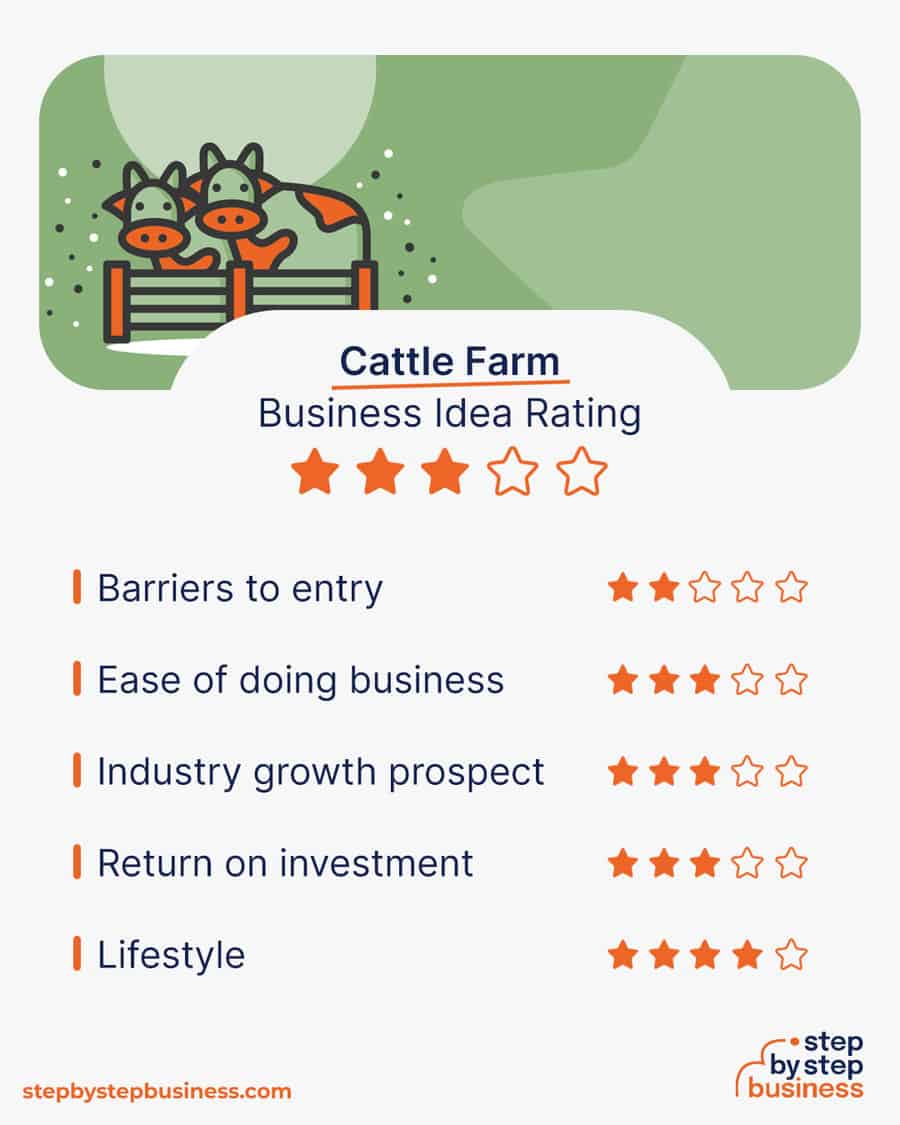
Starting a cattle farm has pros and cons to consider before deciding if it’s right for you.
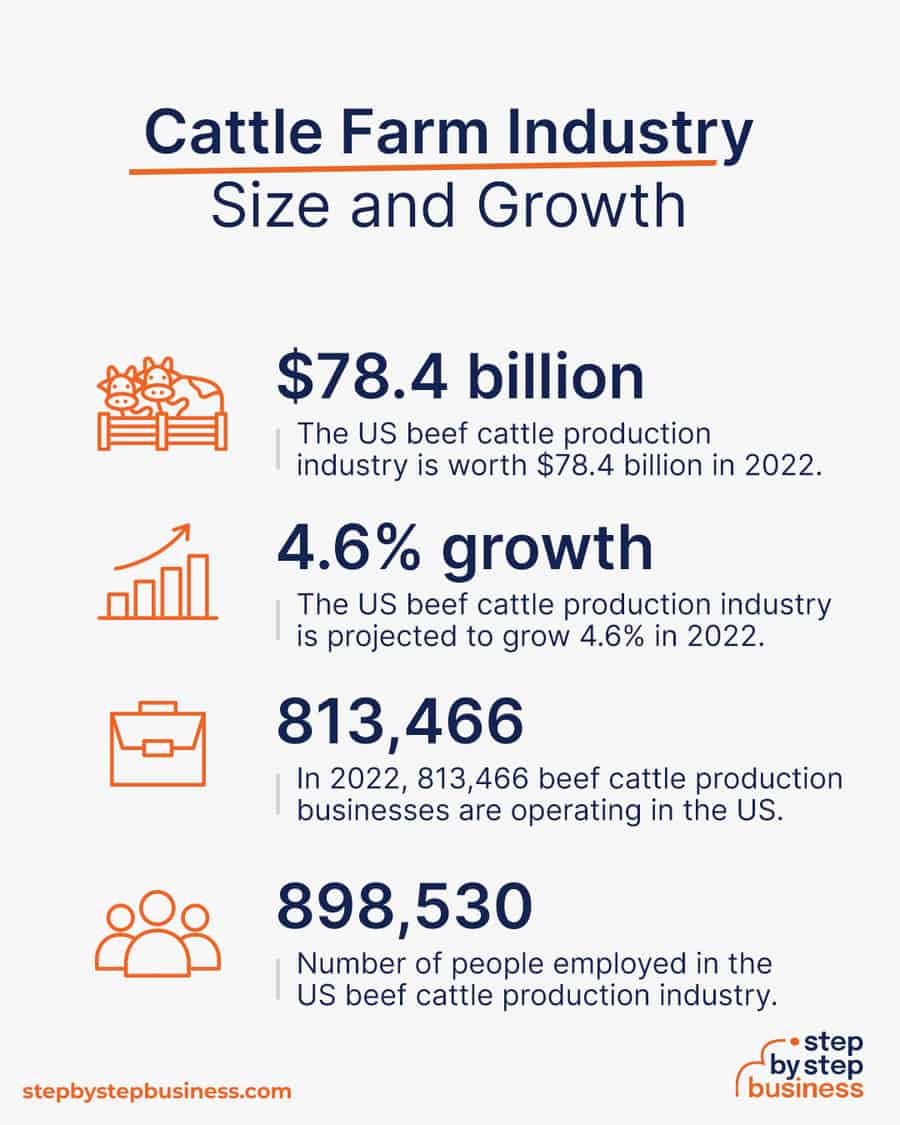
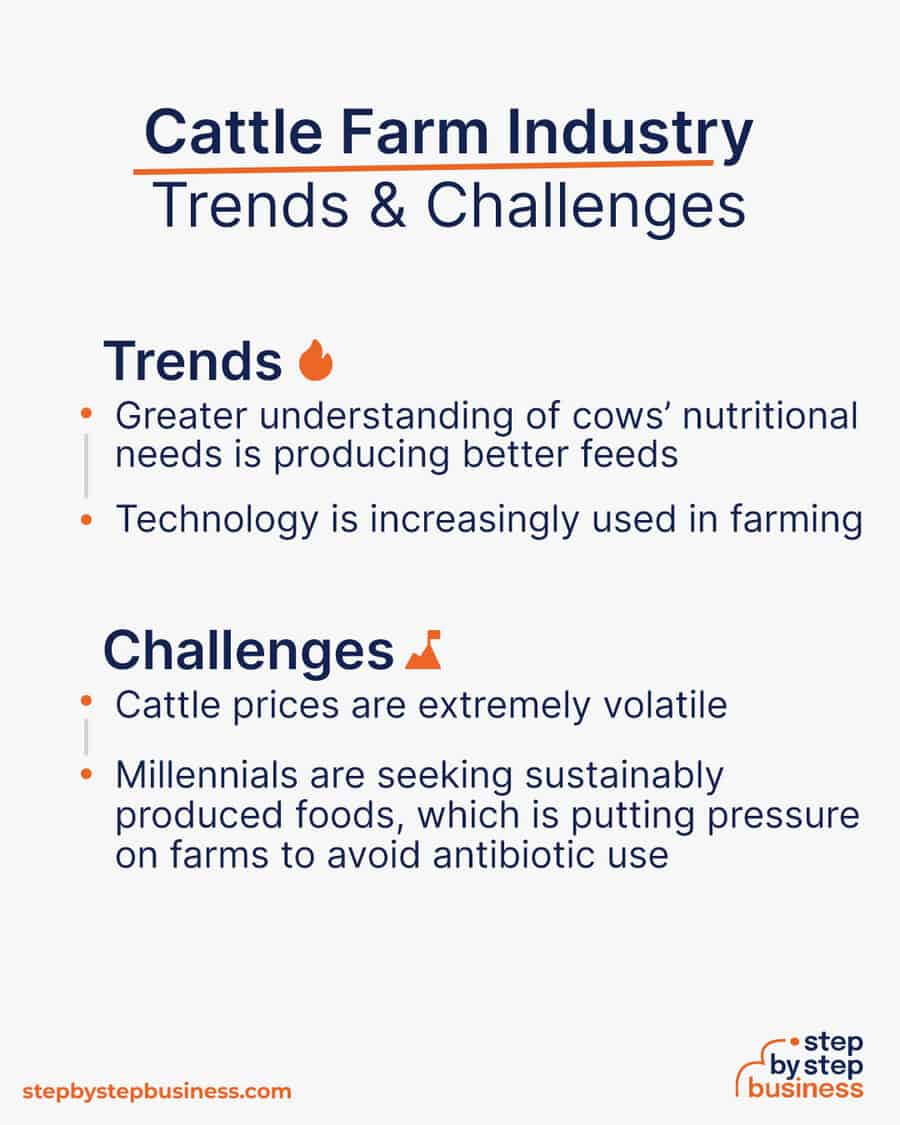
Trends
Challenges
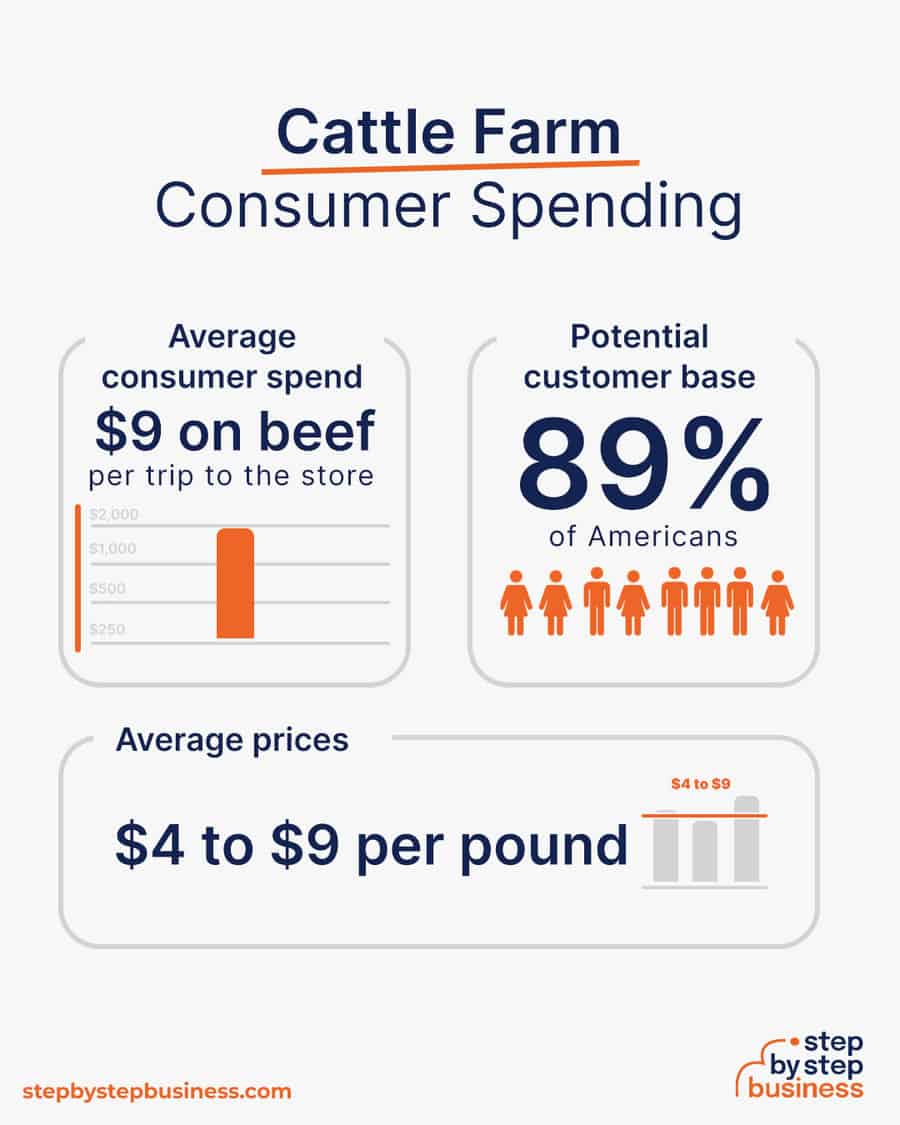
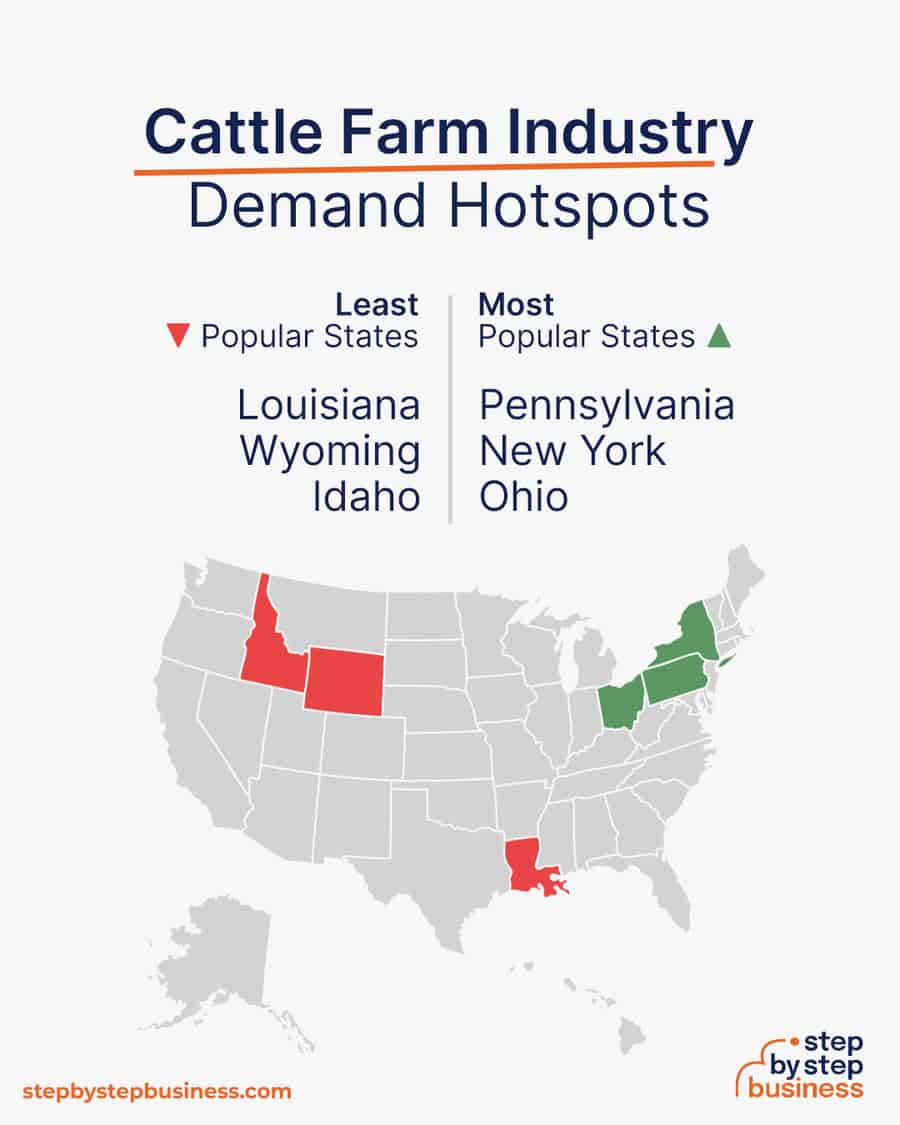
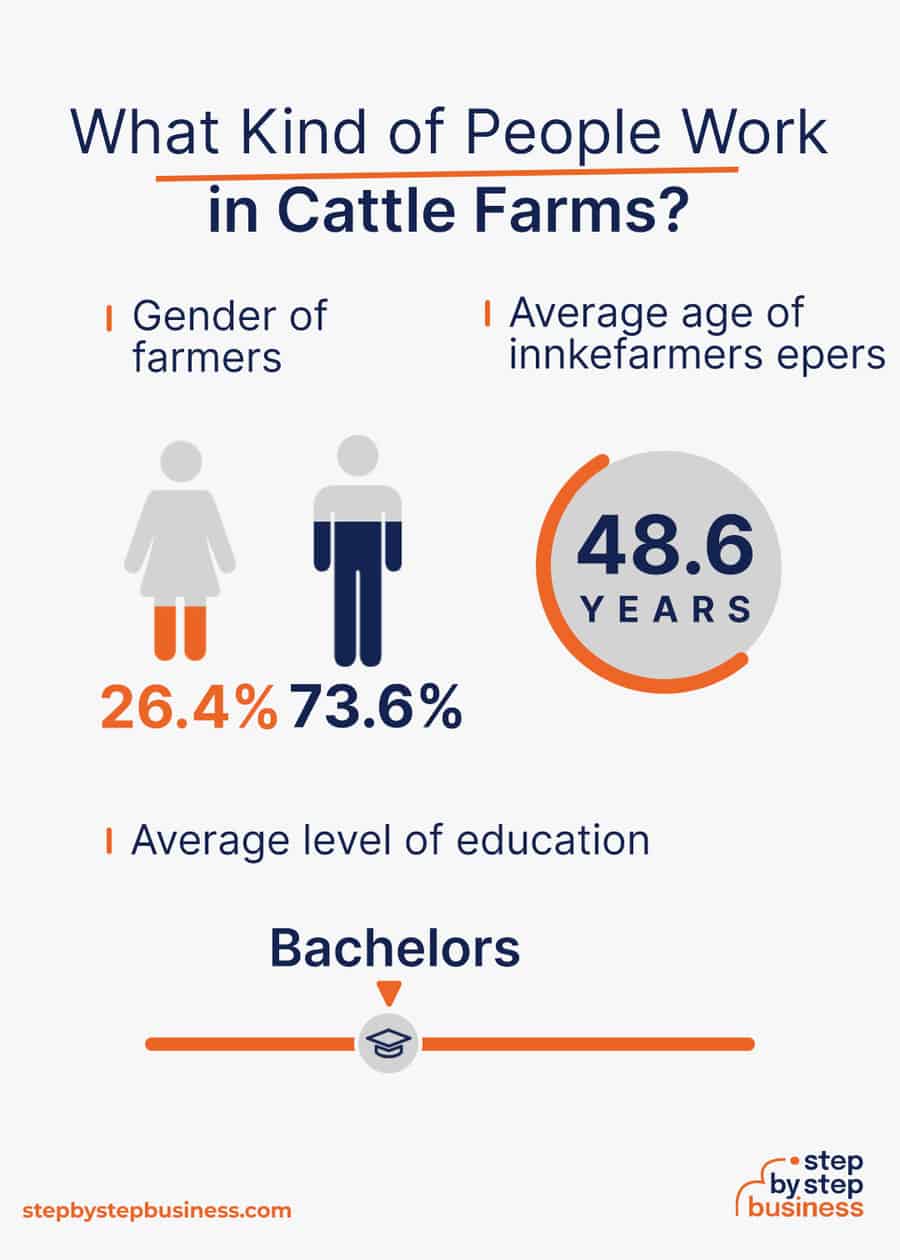
Startup costs for a cattle farm range from $300,000 to $1 million. Costs include the land, land preparation, equipment, starter cattle, and an initial operating budget.
To learn cattle farming, you can get an associate’s or bachelor’s degree in agriculture. You can also get an online agribusiness degree from established institutions like Penn State. Another option is to work as an intern or volunteer for a local cattle farmer to learn the business.
You’ll need a handful of items to successfully launch your cattle farm business, including:
| Start-up Costs | Ballpark Range | Average |
|---|---|---|
| Setting up a business name and corporation | $150–$200 | $175 |
| Business licenses and permits | $100–$300 | $200 |
| Insurance | $100–$300 | $200 |
| Business cards and brochures | $200–$300 | $250 |
| Website setup | $1,000–$3,000 | $2,000 |
| Down payment on property | $100,000–$500,000 | $300,000 |
| Tools and equipment | $20,000–$30,000 | $25,000 |
| Land preparation and fencing | $100,000–$300,000 | $200,000 |
| Operating budget | $50,000–$75,000 | $62,500 |
| Starter cattle | $25,000–$50,000 | $37,500 |
| Total | $296,550–$959,100 | $627,825 |
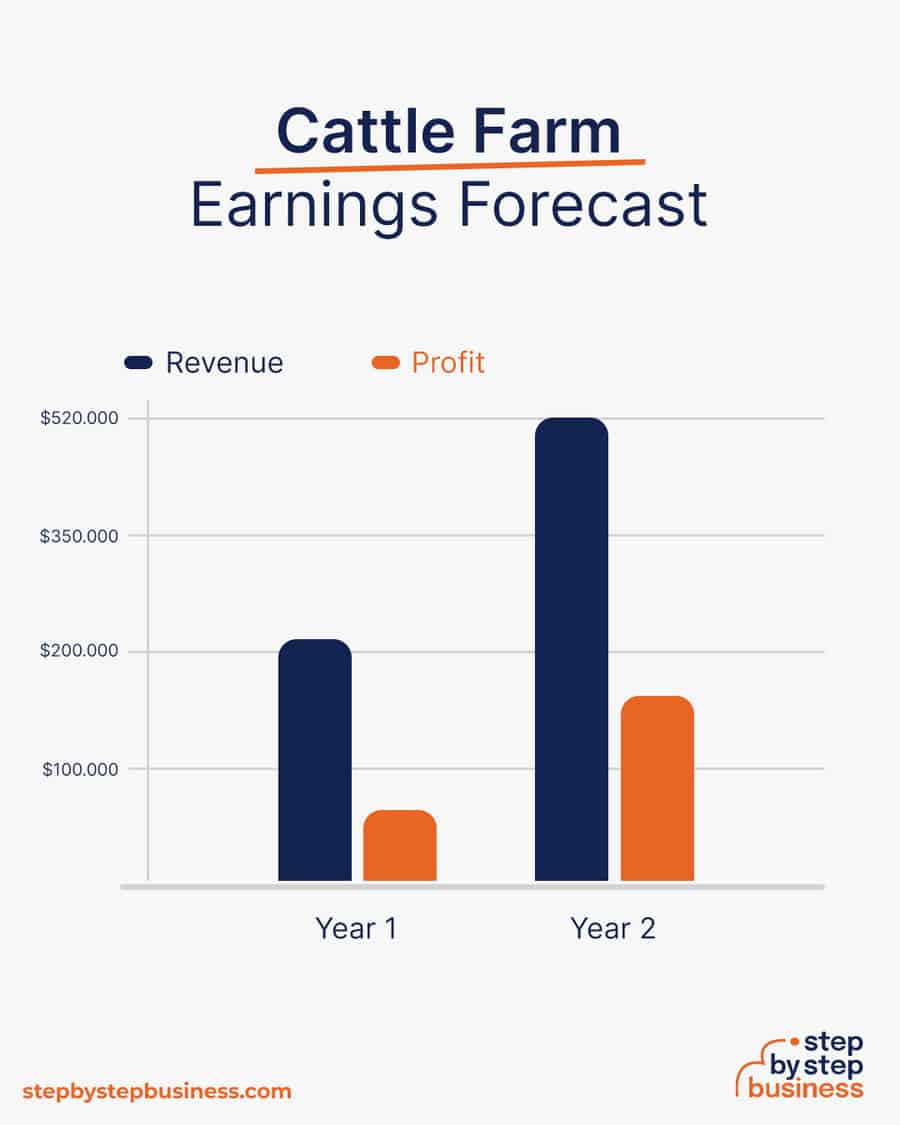
You should be able to bring in $2,000 per cow once they’ve reached full maturity. It will take a year or two to get your calves to that point, so you won’t see a profit for at least 12 months. Your profit margin after all expenses should be about 30%.
In your first year or two after cows reach their ideal weight, you could sell two cows per week, bringing in $208,000 in annual revenue. This would mean $62,000 in profit, assuming that 30% margin. As your herd grows, sales could climb to five cows per week. With an annual revenue of $520,000, you’d make a healthy profit of $156,000.
There are a few barriers to entry for a cattle farm. Your biggest challenges will be:
If you’re still not sure whether this business idea is the right choice for you, here are some related business opportunities to help you on your path to entrepreneurial success.
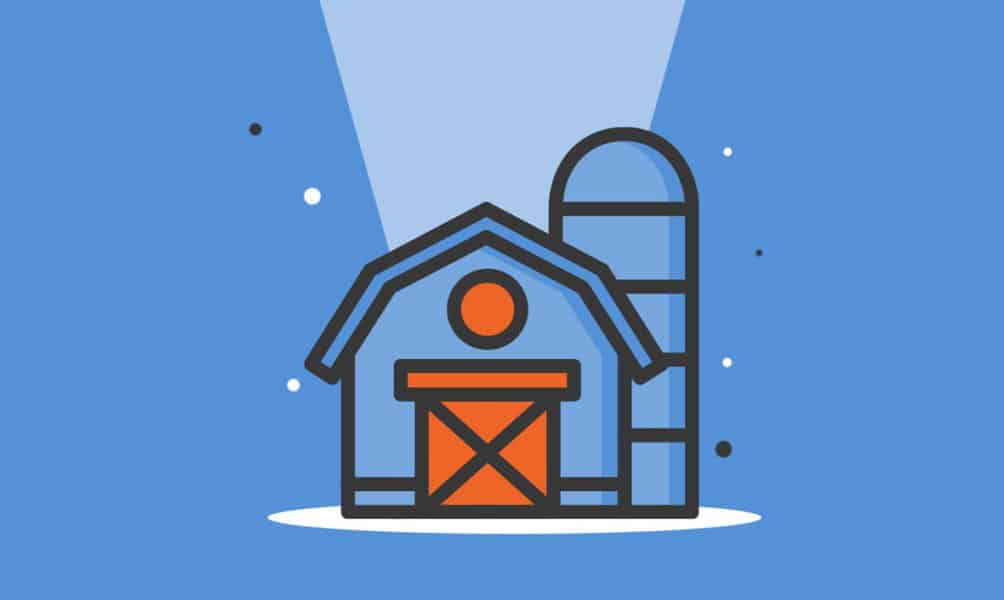


Now that you know what’s involved in starting a cattle farm, it’s a good idea to hone your concept in preparation to enter a competitive market.
Market research will give you the upper hand, even if you’re already positive that you have a perfect product or service. Conducting market research is important because it can help you understand your customers better, who your competitors are, and your business landscape.
Research cattle farms in your area to examine their products/services, price points, and customer reviews. You’re looking for a market gap to fill. For instance, maybe the local market is missing an organic dairy farm or a sustainable, grass-fed beef farm.
![]()
You might consider targeting a niche market by specializing in a certain aspect of your industry, such as black Angus cows or longhorn cows, or fully organic and chemical-free beef and dairy.
This could jumpstart your word-of-mouth marketing and attract clients right away.
You’ll just need to decide what types of cattle you want to raise. You could raise dairy cows, or you can raise cows for beef. You could raise them with chemicals and growth hormones or go fully organic and sustainable. You could also raise other livestock like chickens and pigs for additional revenue.
Prices for cows are very volatile, so it will depend on the market at any given time. Cows are sold by their total weight. They are currently being sold for about $130 per 100 pounds. You should aim for a profit margin after operating expenses of about 30%.
Once you know your costs, you can use our profit margin calculator to determine your markup and final price points. Remember that the prices you use at launch should be subject to change if warranted by the market.
Your target market will be food production companies, butchers, grocery stores, and restaurants. You can find those business owners and connect with them on LinkedIn, but your best bet is to find them on Google or Yelp and call them directly.
Selecting the right location for your cattle farm is essential for its success. Look for a spot with abundant pastureland, access to clean water, and good drainage. Consider accessibility and convenience, ensuring that the location is easily reachable by transportation vehicles and has easy access to veterinary services and other supplies.
Additionally, assess the local regulations and zoning laws to ensure compliance and obtain any necessary permits. By strategically choosing the right location, you can establish a thriving and profitable cattle farm that produces high-quality meat and dairy products.
Here are some ideas for brainstorming your business name:
![]()
Discover over 250 unique cattle farm name ideas here. If you want your business name to include specific keywords, you can also use our cattle farm business name generator. Just type in a few keywords, hit Generate, and you’ll have dozens of suggestions at your fingertips.
Once you’ve got a list of potential names, visit the website of the US Patent and Trademark Office to make sure they are available for registration and check the availability of related domain names using our Domain Name Search tool. Using “.com” or “.org” sharply increases credibility, so it’s best to focus on these.
Powered by GoDaddy.com
Finally, make your choice among the names that pass this screening and go ahead with domain registration and social media account creation. Your business name is one of the key differentiators that sets your business apart. Once you pick your company name and start with the branding, it is hard to change the business name. Therefore, it’s important to carefully consider your choice before you start a business entity.
Here are the key components of a business plan:

If you’ve never created a business plan, it can be an intimidating task. You might consider hiring a business plan specialist to create a top-notch business plan for you.
Registering your business is an absolutely crucial step — it’s the prerequisite to paying taxes, raising capital, opening a bank account, and other guideposts on the road to getting a business up and running.
Plus, registration is exciting because it makes the entire process official. Once it’s complete, you’ll have your own business!
Your business location is important because it can affect taxes, legal requirements, and revenue. Most people register their business in the state where they live, but if you’re planning to expand, you might consider looking elsewhere, as some states could offer real advantages when it comes to cattle farms.
If you’re willing to move, you could really maximize your business! Keep in mind that it’s relatively easy to transfer your business to another state.
Business entities come in several varieties, each with its pros and cons. The legal structure you choose for your cattle farm will shape your taxes, personal liability, and business registration requirements, so choose wisely.
Here are the main options:

We recommend that new business owners choose LLC as it offers liability protection and pass-through taxation while being simpler to form than a corporation. You can form an LLC in as little as five minutes using an online LLC formation service. They will check that your business name is available before filing, submit your articles of organization, and answer any questions you might have.
Choose Your State
We recommend ZenBusiness as the Best LLC Service for 2024
starts at $0, plus state fees starts at $0, plus state feesThe final step before you’re able to pay taxes is getting an Employer Identification Number or EIN. You can file for your EIN online or by mail/fax. Visit the IRS website to learn more. Keep in mind, if you’ve chosen to be a sole proprietorship, you can simply use your social security number as your EIN.
Once you have your EIN, you’ll need to choose your tax year. Financially speaking, your business will operate in a calendar year (January–December) or a fiscal year, a 12-month period that can start in any month. This will determine your tax cycle, while your business structure will determine which taxes you’ll pay.
![]()
The IRS website also offers a tax-payers checklist, and taxes can be filed online.
It is important to consult an accountant or other professional to help you with your taxes to ensure you’re completing them correctly.
Securing financing is your next step, and there are plenty of ways to raise capital:

You can visit the USDA website to find various loan and grant programs for startup farms. That’s probably your best bet for financing, although bank loans may also be an option.
Starting a cattle farm business requires obtaining a number of licenses and permits from local, state, and federal governments.
You should contact your state’s Department of Agriculture to find out if any specific cattle farm licenses or permits are required in your state.
Federal regulations, licenses, and permits associated with starting your business include doing business as (DBA), health licenses and permits from the Occupational Safety and Health Administration (OSHA), trademarks, copyrights, patents, and other intellectual properties, as well as industry-specific licenses and permits.
You may also need state-level and local county or city-based licenses and permits. The license requirements and how to obtain them vary, so check the websites of your state, city, and county governments or contact the appropriate person to learn more.
You could also check this SBA guide for your state’s requirements, but we recommend using MyCorporation’s Business License Compliance Package. They will research the exact forms you need for your business and state and provide them to ensure you’re fully compliant.
This is not a step to be taken lightly, as failing to comply with legal requirements can result in hefty penalties.
If you feel overwhelmed by this step or don’t know how to begin, it might be a good idea to hire a professional to help you check all the legal boxes.
Before you start making money, you’ll need a place to keep it, and that requires opening a bank account.
Keeping your business finances separate from your personal account makes it easy to file taxes and track your company’s income, so it’s worth doing even if you’re running your cattle farm business as a sole proprietorship. Opening a business bank account is quite simple and similar to opening a personal one. Most major banks offer accounts tailored for businesses — just inquire at your preferred bank to learn about their rates and features.
Banks vary in terms of offerings, so it’s a good idea to examine your options and select the best plan for you. Once you choose your bank, bring in your EIN (or Social Security Number if you decide on a sole proprietorship), articles of incorporation, and other legal documents and open your new account.
Business insurance is an area that often gets overlooked yet it can be vital to your success as an entrepreneur. Insurance protects you from unexpected events that can have a devastating impact on your business.
Here are some types of insurance to consider:

As opening day nears, prepare for launch by reviewing and improving some key elements of your business.
Being an entrepreneur often means wearing many hats, from marketing to sales to accounting, which can be overwhelming. Fortunately, many websites and digital tools are available to help simplify many business tasks.
You may want to use industry-specific software, such as CattleMax or folio3, to manage your herds, quality, sales, and reports.
Website development is crucial because your site is your online presence and needs to convince prospective clients of your expertise and professionalism.
You can create your own website using website builders. This route is very affordable, but figuring out how to build a website can be time-consuming. If you lack tech savvy, you can hire a web designer or developer to create a custom website for your business.
However, people are unlikely to find your website unless you follow Search Engine Optimization (SEO) practices. These are steps that help pages rank higher in the results of top search engines like Google.
Here are some powerful marketing strategies for your future business:

Unique selling propositions, or USPs, are the characteristics of a product or service that set it apart from the competition. Customers today are inundated with buying options, so you’ll have a real advantage if they are able to quickly grasp how your cattle farm meets their needs or wishes. It’s wise to do all you can to ensure your USPs stand out on your website and in your marketing and promotional materials, stimulating buyer desire.
Global pizza chain Domino’s is renowned for its USP: “Hot pizza in 30 minutes or less, guaranteed.” Signature USPs for your cattle farm could be:
You may not like to network or use personal connections for business gain but your personal and professional networks likely offer considerable untapped business potential. Maybe that Facebook friend you met in college is now running a cattle farm business, or a LinkedIn contact of yours is connected to dozens of potential clients. Maybe your cousin or neighbor has been working in cattle farms for years and can offer invaluable insight and industry connections.
The possibilities are endless, so it’s a good idea to review your personal and professional networks and reach out to those with possible links to or interest in cattle farms. You’ll probably generate new customers or find companies with which you could establish a partnership.
If you’re starting out small from a home office, you may not need any employees. But as your business grows, you will likely need workers to fill various roles. Potential positions for a cattle farm business include:
At some point, you may need to hire all of these positions or simply a few, depending on the size and needs of your business. You might also hire multiple workers for a single role or a single worker for multiple roles, again depending on need.
Free-of-charge methods to recruit employees include posting ads on popular platforms such as LinkedIn, Facebook, or Jobs.com. You might also consider a premium recruitment option, such as advertising on Indeed, Glassdoor, or ZipRecruiter. Further, if you have the resources, you could consider hiring a recruitment agency to help you find talent.
If you’ve always dreamed of farm life, your dream can become a reality. You can join an important and thriving industry, make a good living, and provide quality foods to growing families. It will take time, diligence, and a significant investment, but if you have a passion for farming and for producing good food, you can build a lucrative cattle operation.
You’ve got a good understanding of the business now, so it’s time to put on your work boots, roll up your sleeves, and launch your successful cattle farm.